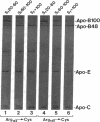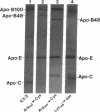Abstract
Familial dysbetalipoproteinemia (or type III hyperlipoproteinemia) is characterized by the presence of abnormal, cholesteryl ester-rich beta-very low density lipoproteins (beta-VLDL) in the plasma. Subjects with typical dysbetalipoproteinemia are homozygous for an amino acid substitution in apolipoprotein (apo-) E at residue 158 and have defective apo-E-mediated binding of both pre-beta-VLDL and beta-VLDL to apo-B,E(LDL) (or LDL) receptors (1988. Chappell, D.A., J. Clin. Invest. 82:628-639). To understand the effect of substitutions in apo-E at sites other than residue 158, nine dysbetalipoproteinemic (dys-beta) subjects who were either homozygous or heterozygous for substitutions in apo-E at atypical sites were studied. These substitutions occurred at residue 142 (n = 6), 145 (n = 2), or 146 (n = 1) and are known to cause less defective binding than does the 158 substitution. The chemical composition and electrophoretic mobility of pre-beta-VLDL and beta-VLDL from atypical and typical dys-beta subjects were indistinguishable. However, lipoproteins from atypical and typical dys-beta subjects differed in their affinity for the apo-B,E(LDL) receptor on cultured human fibroblasts. The pre-beta-VLDL and beta-VLDL from atypical dys-beta subjects had 640- or 17-fold higher affinity, respectively, than did corresponding lipoproteins from typical dys-beta subjects. The higher binding affinity of lipoproteins from atypical dys-beta subjects was associated with a higher ratio of apo-E to total apo-C. Since higher binding affinity should cause more rapid receptor-mediated clearance of beta-VLDL in atypical than in typical dys-beta subjects in vivo, the mechanism of beta-VLDL accumulation may differ in these two groups.
Full text
PDF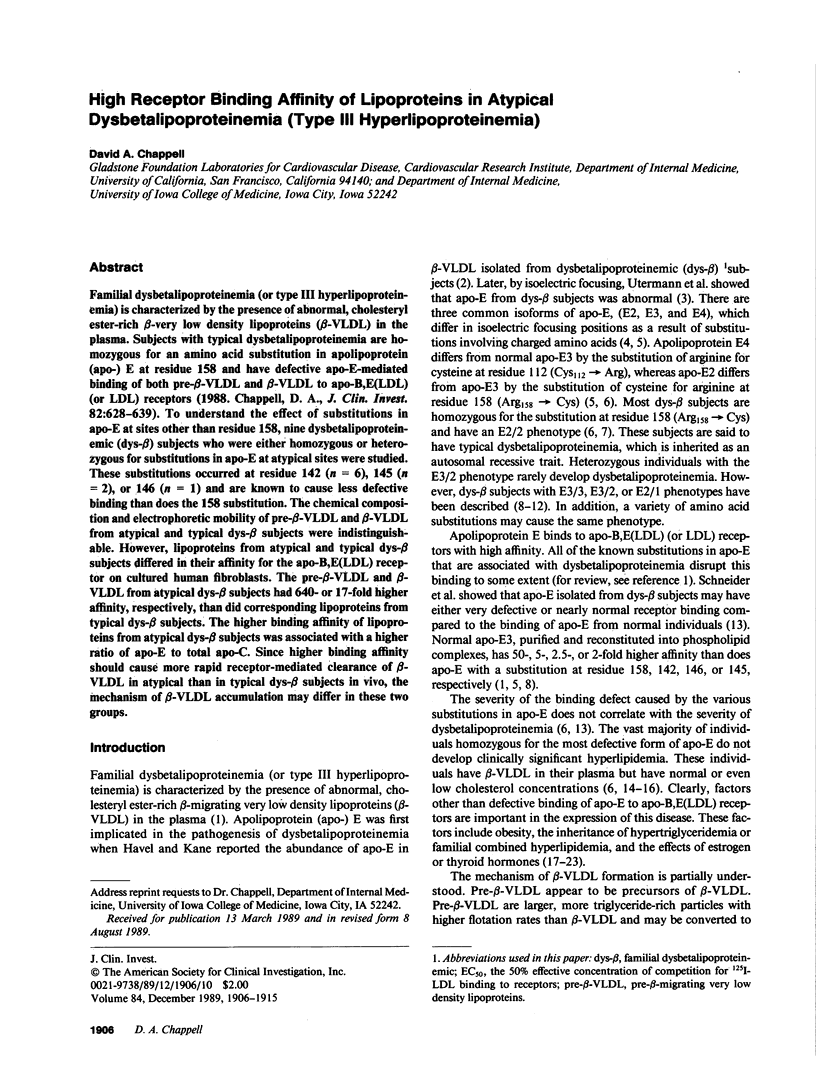

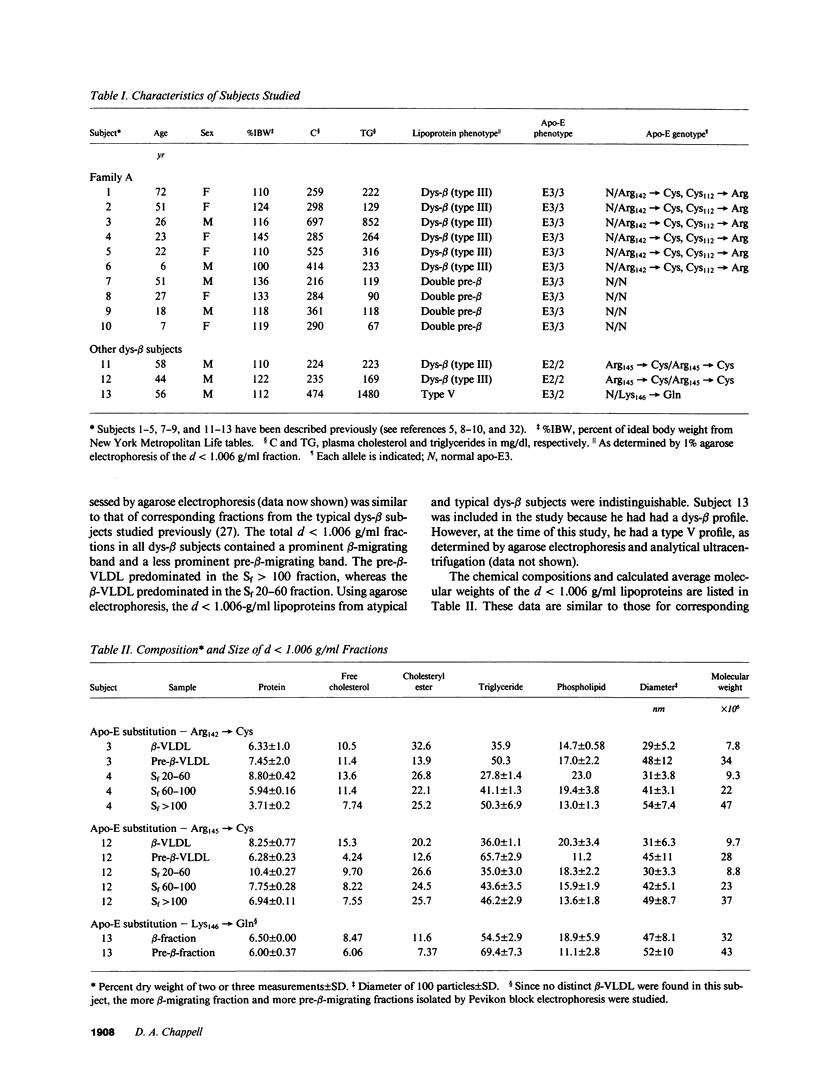


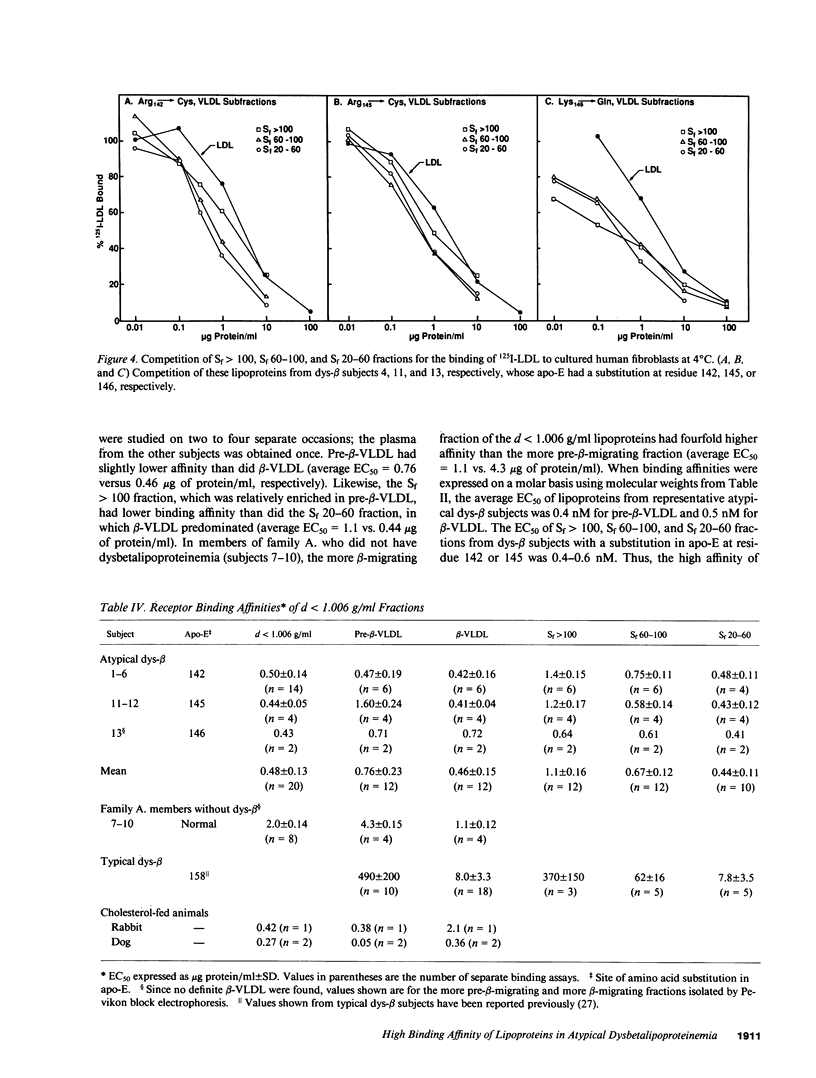
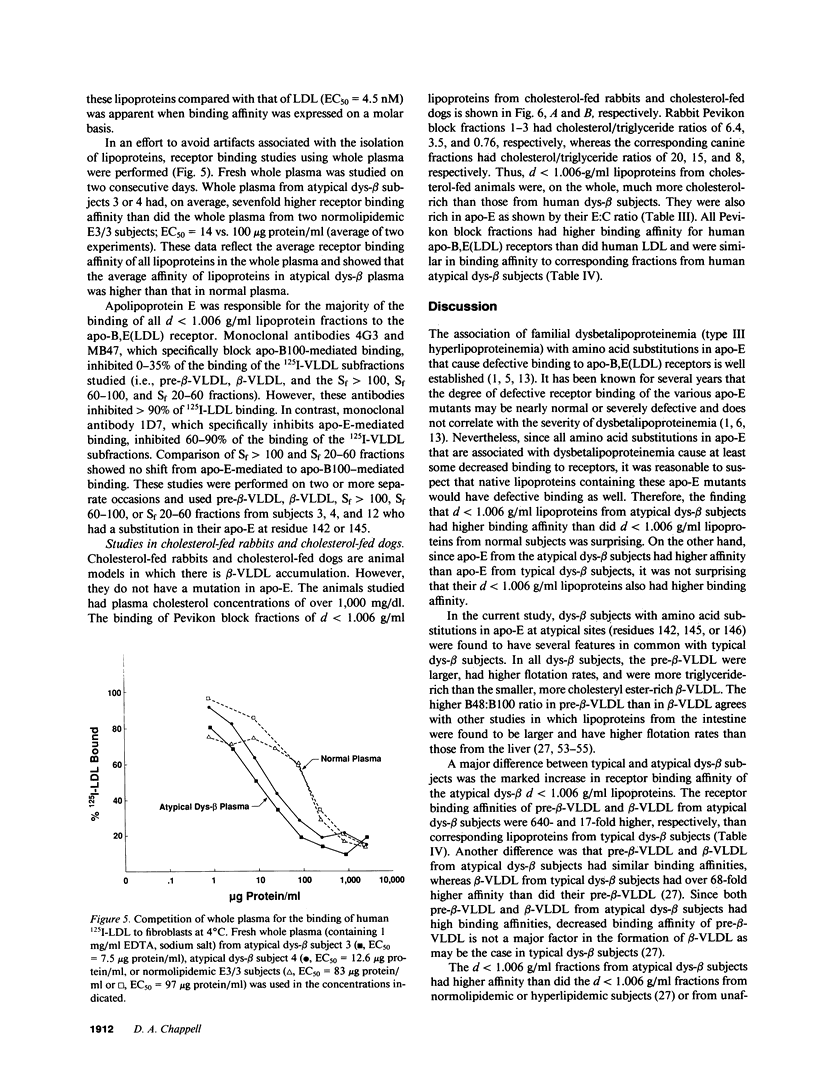
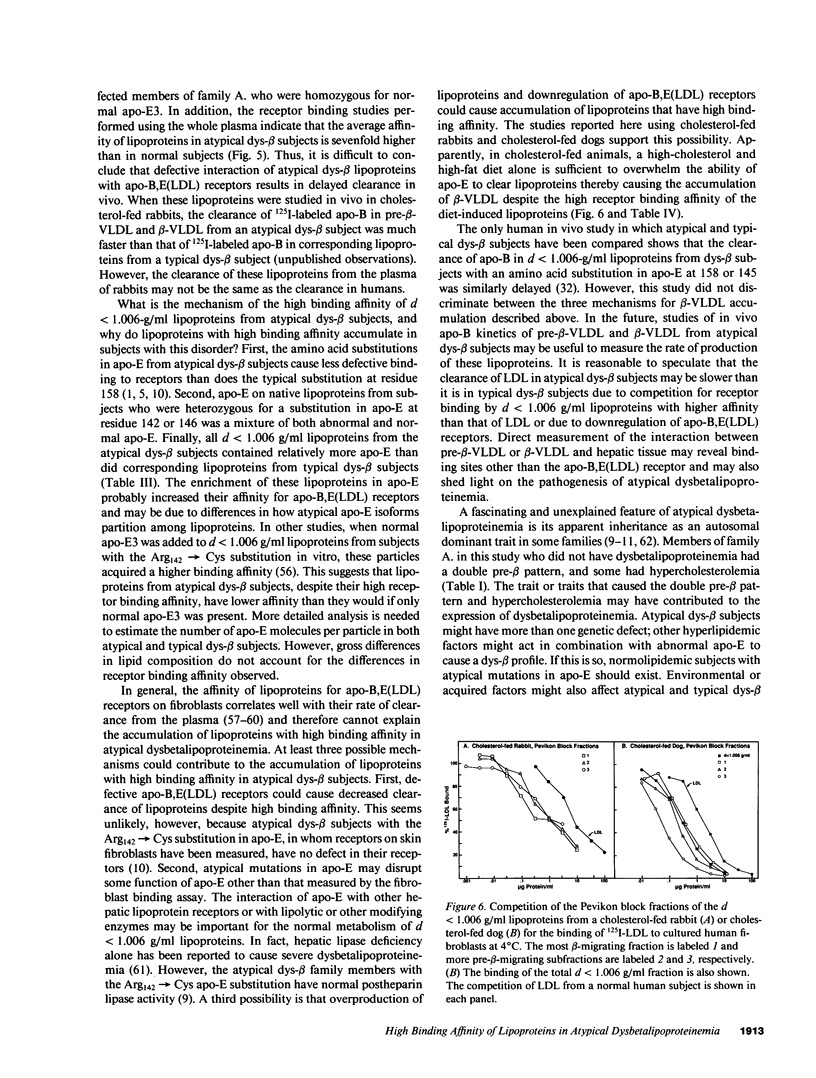
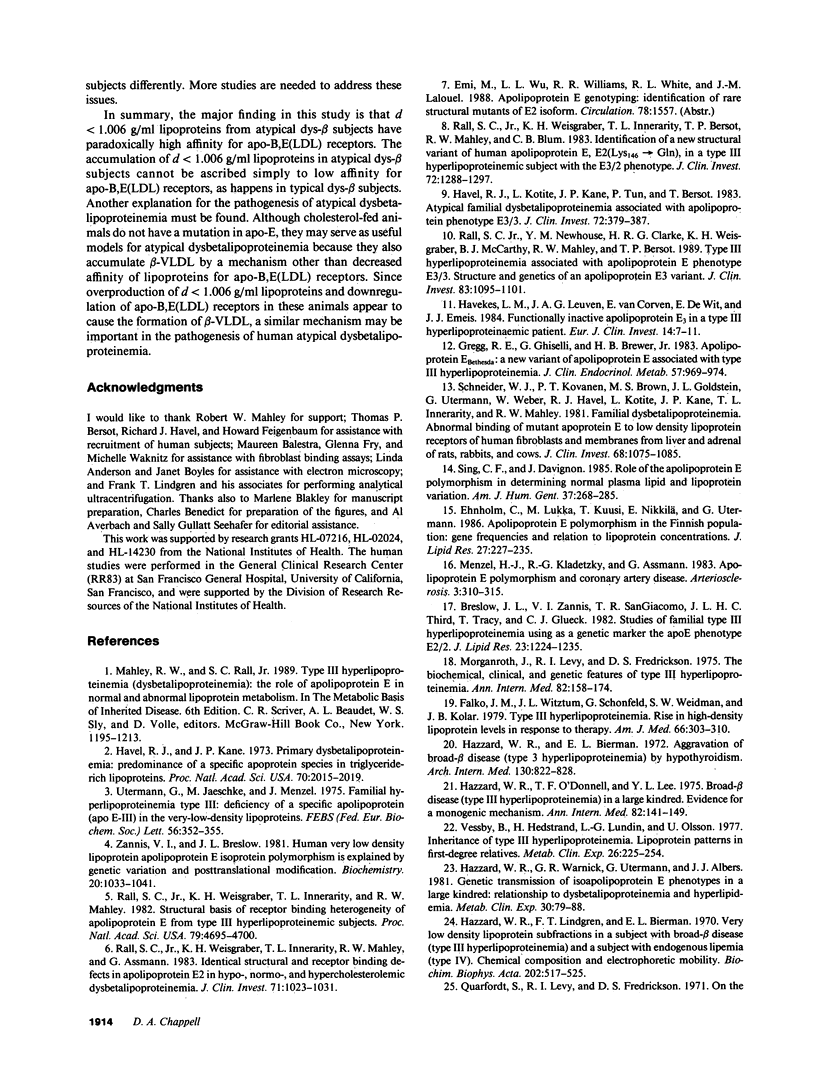
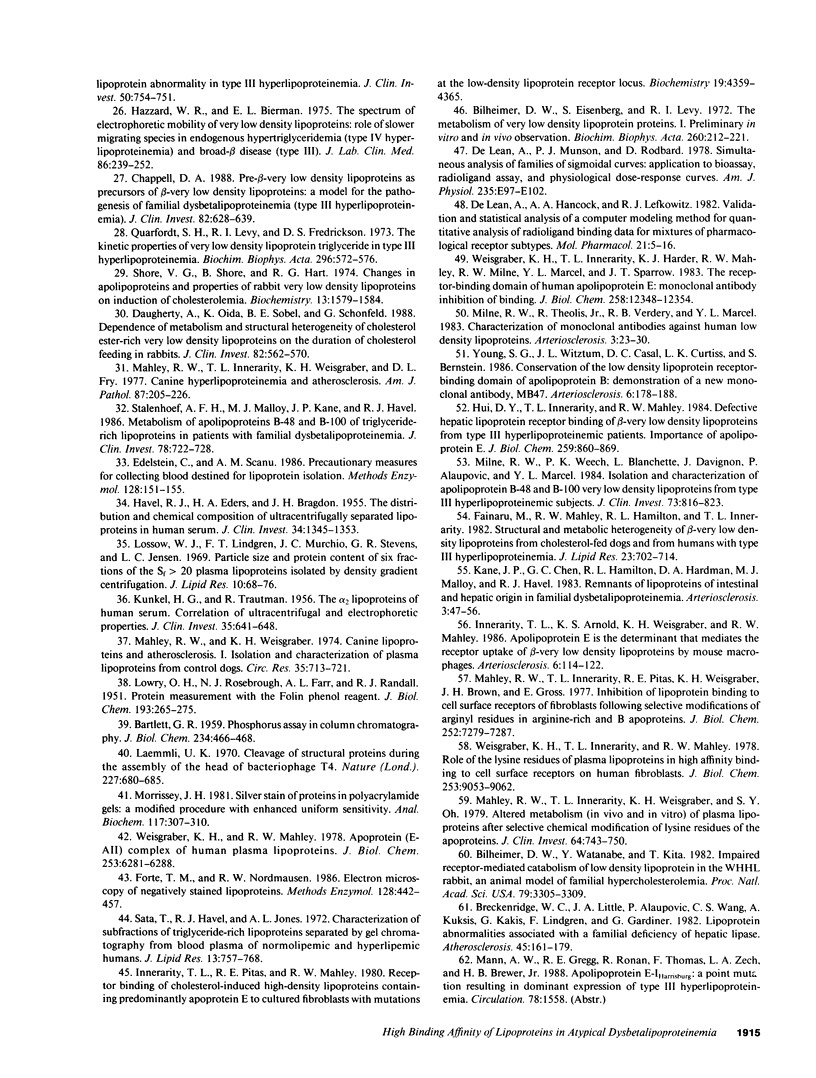
Images in this article
Selected References
These references are in PubMed. This may not be the complete list of references from this article.
- BARTLETT G. R. Phosphorus assay in column chromatography. J Biol Chem. 1959 Mar;234(3):466–468. [PubMed] [Google Scholar]
- Bilheimer D. W., Eisenberg S., Levy R. I. The metabolism of very low density lipoprotein proteins. I. Preliminary in vitro and in vivo observations. Biochim Biophys Acta. 1972 Feb 21;260(2):212–221. doi: 10.1016/0005-2760(72)90034-3. [DOI] [PubMed] [Google Scholar]
- Bilheimer D. W., Watanabe Y., Kita T. Impaired receptor-mediated catabolism of low density lipoprotein in the WHHL rabbit, an animal model of familial hypercholesterolemia. Proc Natl Acad Sci U S A. 1982 May;79(10):3305–3309. doi: 10.1073/pnas.79.10.3305. [DOI] [PMC free article] [PubMed] [Google Scholar]
- Breckenridge W. C., Little J. A., Alaupovic P., Wang C. S., Kuksis A., Kakis G., Lindgren F., Gardiner G. Lipoprotein abnormalities associated with a familial deficiency of hepatic lipase. Atherosclerosis. 1982 Nov;45(2):161–179. doi: 10.1016/0021-9150(82)90136-8. [DOI] [PubMed] [Google Scholar]
- Breslow J. L., Zannis V. I., SanGiacomo T. R., Third J. L., Tracy T., Glueck C. J. Studies of familial type III hyperlipoproteinemia using as a genetic marker the apoE phenotype E2/2. J Lipid Res. 1982 Nov;23(8):1224–1235. [PubMed] [Google Scholar]
- Chappell D. A. Pre-beta-very low density lipoproteins as precursors of beta-very low density lipoproteins. A model for the pathogenesis of familial dysbetalipoproteinemia (type III hyperlipoproteinemia). J Clin Invest. 1988 Aug;82(2):628–639. doi: 10.1172/JCI113642. [DOI] [PMC free article] [PubMed] [Google Scholar]
- Daugherty A., Oida K., Sobel B. E., Schonfeld G. Dependence of metabolic and structural heterogeneity of cholesterol ester-rich very low density lipoproteins on the duration of cholesterol feeding in rabbits. J Clin Invest. 1988 Aug;82(2):562–570. doi: 10.1172/JCI113633. [DOI] [PMC free article] [PubMed] [Google Scholar]
- De Lean A., Hancock A. A., Lefkowitz R. J. Validation and statistical analysis of a computer modeling method for quantitative analysis of radioligand binding data for mixtures of pharmacological receptor subtypes. Mol Pharmacol. 1982 Jan;21(1):5–16. [PubMed] [Google Scholar]
- DeLean A., Munson P. J., Rodbard D. Simultaneous analysis of families of sigmoidal curves: application to bioassay, radioligand assay, and physiological dose-response curves. Am J Physiol. 1978 Aug;235(2):E97–102. doi: 10.1152/ajpendo.1978.235.2.E97. [DOI] [PubMed] [Google Scholar]
- Edelstein C., Scanu A. M. Precautionary measures for collecting blood destined for lipoprotein isolation. Methods Enzymol. 1986;128:151–155. doi: 10.1016/0076-6879(86)28065-9. [DOI] [PubMed] [Google Scholar]
- Ehnholm C., Lukka M., Kuusi T., Nikkilä E., Utermann G. Apolipoprotein E polymorphism in the Finnish population: gene frequencies and relation to lipoprotein concentrations. J Lipid Res. 1986 Mar;27(3):227–235. [PubMed] [Google Scholar]
- Fainaru M., Mahley R. W., Hamilton R. L., Innerarity T. L. Structural and metabolic heterogeneity of beta-very low density lipoproteins from cholesterol-fed dogs and from humans with type III hyperlipoproteinemia. J Lipid Res. 1982 Jul;23(5):702–714. [PubMed] [Google Scholar]
- Falko J. M., Witztum J. L., Schonfeld G., Weidman S. W., Kolar J. B. Type III hyperlipoproteinemia: rise in high-density lipoprotein levels in response to therapy. Am J Med. 1979 Feb;66(2):303–310. doi: 10.1016/0002-9343(79)90553-9. [DOI] [PubMed] [Google Scholar]
- Forte T. M., Nordhausen R. W. Electron microscopy of negatively stained lipoproteins. Methods Enzymol. 1986;128:442–457. doi: 10.1016/0076-6879(86)28086-6. [DOI] [PubMed] [Google Scholar]
- Gregg R. E., Ghiselli G., Brewer H. B., Jr Apolipoprotein EBethesda: a new variant of apolipoprotein E associated with type III hyperlipoproteinemia. J Clin Endocrinol Metab. 1983 Nov;57(5):969–974. doi: 10.1210/jcem-57-5-969. [DOI] [PubMed] [Google Scholar]
- HAVEL R. J., EDER H. A., BRAGDON J. H. The distribution and chemical composition of ultracentrifugally separated lipoproteins in human serum. J Clin Invest. 1955 Sep;34(9):1345–1353. doi: 10.1172/JCI103182. [DOI] [PMC free article] [PubMed] [Google Scholar]
- Havel R. J., Kane J. P. Primary dysbetalipoproteinemia: predominance of a specific apoprotein species in triglyceride-rich lipoproteins. Proc Natl Acad Sci U S A. 1973 Jul;70(7):2015–2019. doi: 10.1073/pnas.70.7.2015. [DOI] [PMC free article] [PubMed] [Google Scholar]
- Havel R. J., Kotite L., Kane J. P., Tun P., Bersot T. Atypical familial dysbetalipoproteinemia associated with apolipoprotein phenotype E3/3. J Clin Invest. 1983 Jul;72(1):379–387. doi: 10.1172/JCI110978. [DOI] [PMC free article] [PubMed] [Google Scholar]
- Hazzard E. R., Bierman E. L. The spectrum of electrophoretic mobility of very low density lipoproteins: role of slower migrating species in endogenous hypertriglyceridemia (type IV hyperlipoproteinemia) and broad-beta disease (type III). J Lab Clin Med. 1975 Aug;86(2):239–252. [PubMed] [Google Scholar]
- Hazzard W. R., Bierman E. L. Aggravation of broad- disease (type 3 hyperlipoproteinemia) by hypothyroidism. Arch Intern Med. 1972 Dec;130(6):822–828. [PubMed] [Google Scholar]
- Hazzard W. R., Lindgren F. T., Bierman E. L. Very low density lipoprotein subfractions in a subject with broad-beta disease (Type 3 hyperlipoproteinemia) and a subject with endogenous lipemia (Type IV). Chemical composition and electrophoretic mobility. Biochim Biophys Acta. 1970 May 5;202(3):517–525. doi: 10.1016/0005-2760(70)90122-0. [DOI] [PubMed] [Google Scholar]
- Hazzard W. R., O'Donnell T. F., Lee Y. L. Broad-beta disease (type III hyperlipoproteinemia) in a large kindred. Evidence for a monogenic mechanism. Ann Intern Med. 1975 Feb;82(2):141–149. doi: 10.7326/0003-4819-82-2-141. [DOI] [PubMed] [Google Scholar]
- Hazzard W. R., Warnick G. R., Utermann G., Albers J. J. Genetic transmission of isoapolipoprotein E phenotypes in a large kindred: relationship to dysbetalipoproteinemia and hyperlipidemia. Metabolism. 1981 Jan;30(1):79–88. doi: 10.1016/0026-0495(81)90223-7. [DOI] [PubMed] [Google Scholar]
- Hui D. Y., Innerarity T. L., Mahley R. W. Defective hepatic lipoprotein receptor binding of beta-very low density lipoproteins from type III hyperlipoproteinemic patients. Importance of apolipoprotein E. J Biol Chem. 1984 Jan 25;259(2):860–869. [PubMed] [Google Scholar]
- Innerarity T. L., Arnold K. S., Weisgraber K. H., Mahley R. W. Apolipoprotein E is the determinant that mediates the receptor uptake of beta-very low density lipoproteins by mouse macrophages. Arteriosclerosis. 1986 Jan-Feb;6(1):114–122. doi: 10.1161/01.atv.6.1.114. [DOI] [PubMed] [Google Scholar]
- Innerarity T. L., Pitas R. E., Mahley R. W. Receptor binding of cholesterol-induced high-density lipoproteins containing predominantly apoprotein E to cultured fibroblasts with mutations at the low-density lipoprotein receptor locus. Biochemistry. 1980 Sep 2;19(18):4359–4365. doi: 10.1021/bi00559a032. [DOI] [PubMed] [Google Scholar]
- KUNKEL H. G., TRAUTMAN R. The alpha2 lipoproteins of human serum; correlation of ultracentrifugal and electrophoretic properties. J Clin Invest. 1956 Jun;35(6):641–648. doi: 10.1172/JCI103320. [DOI] [PMC free article] [PubMed] [Google Scholar]
- Kane J. P., Chen G. C., Hamilton R. L., Hardman D. A., Malloy M. J., Havel R. J. Remnants of lipoproteins of intestinal and hepatic origin in familial dysbetalipoproteinemia. Arteriosclerosis. 1983 Jan-Feb;3(1):47–56. doi: 10.1161/01.atv.3.1.47. [DOI] [PubMed] [Google Scholar]
- LOWRY O. H., ROSEBROUGH N. J., FARR A. L., RANDALL R. J. Protein measurement with the Folin phenol reagent. J Biol Chem. 1951 Nov;193(1):265–275. [PubMed] [Google Scholar]
- Laemmli U. K. Cleavage of structural proteins during the assembly of the head of bacteriophage T4. Nature. 1970 Aug 15;227(5259):680–685. doi: 10.1038/227680a0. [DOI] [PubMed] [Google Scholar]
- Lossow W. J., Lindgren F. T., Murchio J. C., Stevens G. R., Jensen L. C. Particle size and protein content of six fractions of the Sf 20 plasma lipoproteins isolated by density gradient centrifugation. J Lipid Res. 1969 Jan;10(1):68–76. [PubMed] [Google Scholar]
- Mahley R. W., Innerarity T. L., Pitas R. E., Weisgraber K. H., Brown J. H., Gross E. Inhibition of lipoprotein binding to cell surface receptors of fibroblasts following selective modification of arginyl residues in arginine-rich and B apoproteins. J Biol Chem. 1977 Oct 25;252(20):7279–7287. [PubMed] [Google Scholar]
- Mahley R. W., Innerarity T. L., Weisgraber K. B., Oh S. Y. Altered metabolism (in vivo and in vitro) of plasma lipoproteins after selective chemical modification of lysine residues of the apoproteins. J Clin Invest. 1979 Sep;64(3):743–750. doi: 10.1172/JCI109518. [DOI] [PMC free article] [PubMed] [Google Scholar]
- Mahley R. W., Innerarity T. L., Weisgraber K. H., Fry D. L. Canine hyperlipoproteinemia and atherosclerosis. Accumulation of lipid by aortic medial cells in vivo and in vitro. Am J Pathol. 1977 Apr;87(1):205–226. [PMC free article] [PubMed] [Google Scholar]
- Mahley R. W., Weisgraber K. H. Canine lipoproteins and atherosclerosis. I. Isolation and characterization of plasma lipoproteins from control dogs. Circ Res. 1974 Nov;35(5):713–721. doi: 10.1161/01.res.35.5.713. [DOI] [PubMed] [Google Scholar]
- Menzel H. J., Kladetzky R. G., Assmann G. Apolipoprotein E polymorphism and coronary artery disease. Arteriosclerosis. 1983 Jul-Aug;3(4):310–315. doi: 10.1161/01.atv.3.4.310. [DOI] [PubMed] [Google Scholar]
- Milne R. W., Theolis R., Jr, Verdery R. B., Marcel Y. L. Characterization of monoclonal antibodies against human low density lipoprotein. Arteriosclerosis. 1983 Jan-Feb;3(1):23–30. doi: 10.1161/01.atv.3.1.23. [DOI] [PubMed] [Google Scholar]
- Milne R. W., Weech P. K., Blanchette L., Davignon J., Alaupovic P., Marcel Y. L. Isolation and characterization of apolipoprotein B-48 and B-100 very low density lipoproteins from type III hyperlipoproteinemic subjects. J Clin Invest. 1984 Mar;73(3):816–823. doi: 10.1172/JCI111276. [DOI] [PMC free article] [PubMed] [Google Scholar]
- Morganroth J., Levy R. I., Fredrickson D. S. The biochemical, clinical, and genetic features of type III hyperlipoproteinemia. Ann Intern Med. 1975 Feb;82(2):158–174. doi: 10.7326/0003-4819-82-2-158. [DOI] [PubMed] [Google Scholar]
- Morrissey J. H. Silver stain for proteins in polyacrylamide gels: a modified procedure with enhanced uniform sensitivity. Anal Biochem. 1981 Nov 1;117(2):307–310. doi: 10.1016/0003-2697(81)90783-1. [DOI] [PubMed] [Google Scholar]
- Quarfordt S. H., Levy R. I., Frederickson D. S. The kinetic properties of very low density lipoprotein triglyceride in type 3 hyperlipoproteinemia. Biochim Biophys Acta. 1973 Mar 8;296(3):572–576. doi: 10.1016/0005-2760(73)90117-3. [DOI] [PubMed] [Google Scholar]
- Quarfordt S., Levy R. I., Fredrickson D. S. On thelipoprotein abnormality in type 3 hyperlipoproteinemia. J Clin Invest. 1971 Apr;50(4):754–761. doi: 10.1172/JCI106546. [DOI] [PMC free article] [PubMed] [Google Scholar]
- Rall S. C., Jr, Newhouse Y. M., Clarke H. R., Weisgraber K. H., McCarthy B. J., Mahley R. W., Bersot T. P. Type III hyperlipoproteinemia associated with apolipoprotein E phenotype E3/3. Structure and genetics of an apolipoprotein E3 variant. J Clin Invest. 1989 Apr;83(4):1095–1101. doi: 10.1172/JCI113988. [DOI] [PMC free article] [PubMed] [Google Scholar]
- Rall S. C., Jr, Weisgraber K. H., Innerarity T. L., Bersot T. P., Mahley R. W., Blum C. B. Identification of a new structural variant of human apolipoprotein E, E2(Lys146 leads to Gln), in a type III hyperlipoproteinemic subject with the E3/2 phenotype. J Clin Invest. 1983 Oct;72(4):1288–1297. doi: 10.1172/JCI111085. [DOI] [PMC free article] [PubMed] [Google Scholar]
- Rall S. C., Jr, Weisgraber K. H., Innerarity T. L., Mahley R. W. Identical structural and receptor binding defects in apolipoprotein E2 in hypo-, normo-, and hypercholesterolemic dysbetalipoproteinemia. J Clin Invest. 1983 Apr;71(4):1023–1031. doi: 10.1172/JCI110829. [DOI] [PMC free article] [PubMed] [Google Scholar]
- Rall S. C., Jr, Weisgraber K. H., Innerarity T. L., Mahley R. W. Structural basis for receptor binding heterogeneity of apolipoprotein E from type III hyperlipoproteinemic subjects. Proc Natl Acad Sci U S A. 1982 Aug;79(15):4696–4700. doi: 10.1073/pnas.79.15.4696. [DOI] [PMC free article] [PubMed] [Google Scholar]
- Sata T., Havel R. J., Jones A. L. Characterization of subfractions of triglyceride-rich lipoproteins separated by gel chromatography from blood plasma of normolipemic and hyperlipemic humans. J Lipid Res. 1972 Nov;13(6):757–768. [PubMed] [Google Scholar]
- Schneider W. J., Kovanen P. T., Brown M. S., Goldstein J. L., Utermann G., Weber W., Havel R. J., Kotite L., Kane J. P., Innerarity T. L. Familial dysbetalipoproteinemia. Abnormal binding of mutant apoprotein E to low density lipoprotein receptors of human fibroblasts and membranes from liver and adrenal of rats, rabbits, and cows. J Clin Invest. 1981 Oct;68(4):1075–1085. doi: 10.1172/JCI110330. [DOI] [PMC free article] [PubMed] [Google Scholar]
- Shore V. G., Shore B., Hart R. G. Changes in apolipoproteins and properties of rabbit very low density lipoproteins on induction of cholesteremia. Biochemistry. 1974 Apr 9;13(8):1579–1585. doi: 10.1021/bi00705a004. [DOI] [PubMed] [Google Scholar]
- Sing C. F., Davignon J. Role of the apolipoprotein E polymorphism in determining normal plasma lipid and lipoprotein variation. Am J Hum Genet. 1985 Mar;37(2):268–285. [PMC free article] [PubMed] [Google Scholar]
- Stalenhoef A. F., Malloy M. J., Kane J. P., Havel R. J. Metabolism of apolipoproteins B-48 and B-100 of triglyceride-rich lipoproteins in patients with familial dysbetalipoproteinemia. J Clin Invest. 1986 Sep;78(3):722–728. doi: 10.1172/JCI112632. [DOI] [PMC free article] [PubMed] [Google Scholar]
- Utermann G., Jaeschke M., Menzel J. Familial hyperlipoproteinemia type III: deficiency of a specific apolipoprotein (apo E-III) in the very-low-density lipoproteins. FEBS Lett. 1975 Aug 15;56(2):352–355. doi: 10.1016/0014-5793(75)81125-2. [DOI] [PubMed] [Google Scholar]
- Vessby B., Hedstrand H., Lundin L. G., Olsson U. Inheritance of type-III hyperlipoproteinemia. Lipoprotein patterns in first-degree relatives. Metabolism. 1977 Mar;26(3):225–254. doi: 10.1016/0026-0495(77)90071-3. [DOI] [PubMed] [Google Scholar]
- Weisgraber K. H., Innerarity T. L., Harder K. J., Mahley R. W., Milne R. W., Marcel Y. L., Sparrow J. T. The receptor-binding domain of human apolipoprotein E. Monoclonal antibody inhibition of binding. J Biol Chem. 1983 Oct 25;258(20):12348–12354. [PubMed] [Google Scholar]
- Weisgraber K. H., Innerarity T. L., Mahley R. W. Role of lysine residues of plasma lipoproteins in high affinity binding to cell surface receptors on human fibroblasts. J Biol Chem. 1978 Dec 25;253(24):9053–9062. [PubMed] [Google Scholar]
- Weisgraber K. H., Mahley R. W. Apoprotein (E--A-II) complex of human plasma lipoproteins. I. Characterization of this mixed disulfide and its identification in a high density lipoprotein subfraction. J Biol Chem. 1978 Sep 10;253(17):6281–6288. [PubMed] [Google Scholar]
- Young S. G., Witztum J. L., Casal D. C., Curtiss L. K., Bernstein S. Conservation of the low density lipoprotein receptor-binding domain of apoprotein B. Demonstration by a new monoclonal antibody, MB47. Arteriosclerosis. 1986 Mar-Apr;6(2):178–188. doi: 10.1161/01.atv.6.2.178. [DOI] [PubMed] [Google Scholar]
- Zannis V. I., Breslow J. L. Human very low density lipoprotein apolipoprotein E isoprotein polymorphism is explained by genetic variation and posttranslational modification. Biochemistry. 1981 Feb 17;20(4):1033–1041. doi: 10.1021/bi00507a059. [DOI] [PubMed] [Google Scholar]



